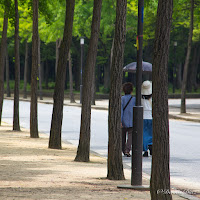I was soon back at the hotel after a quick 10K run. The cold morning air still chilled my spine as
I stood infront of the elevator. After a
short stretch and a hot shower, I headed down for breakfast. Time felt slower when not chasing
pavement. Short relaxing conversations
over breakfast with colleagues and professors felt warm and pleasant in
contrast to the cold and shin-splinting pace of my very early morning. There wasn’t any apparent immediate
hurry. There was even time for a quick hop
upstairs for ‘#no.2’ just before everyone headed out. I got back to the hotel lobby, however, and
found everyone waiting for me. Time ran
faster all of a sudden. I counted
heads. Yes, I was indeed last. It felt as awkward as the first time I was
late and my apologies felt even more embarrassing.
We walked along the linear park that meandered with the dark
blue Osaka River threading out from the city and into the sea. The walk, already a familiar path to me from
the morning run, took us to a small jetty.
We took the “Aqua Bus”, a frog looking boat, and headed up river towards
Osakajo Pier (Osaka Castle Port). The
wide linear parks on both banks and the river itself formed a natural feature,
clean and vibrant amidst the city sprawling with progressive high-rise urban
development. The entire scenery as seen
from the ferry showed the wide-open berth between built-form and the natural
feature of the river. The complementary co-existence in one simple setting was
enviable. The composition was perfect. There was blue from the river, white from the
clouds, and green from the park. The
gradual rise of structures allowed the horizons to stretch clean of
buildings. The view of the sky and the
clouds was wide and unobstructed. Though
we weren’t able to visit the park at night I could imagine the moon’s sharp
reflection over the river on a breezy walk under a starless sky. In a country with four seasons the design was
four times impressive.
The ferry took us towards Osaka Castle, one of Japan’s most
treasured architectural relics. The castle rested on a land
area of nearly 60,000 square meters. It
was completed in 1597 under Daimyo Toyotomi Hideyoshi of the Sengoku period but
was reconstructed several times thereafter brought about by damage during
different feudal wars. A huge fire
consumed and leveled the main tower.[1] Much of it has been
carefully restored allowing it to stand tall again, visible from within Osaka’s
business district. The 5-storey high
wonder of wood, stone, and now also of concrete currently functioned as a museum
housing old Japanese artifacts such as old samurai armors, katanas, naginatas,
and other archaic weapons of war. Walls
were covered in framed paintings of battles fought during the different times
of feudal Japan. Though the museum
depicted a brutal image of an old nation soaked in battles and gore, it similarly
showcased the intricate patterns of design evident in swords, armors and war
masks. I could almost feel the spirit of
a people obsessed with the fullest realization of discipline and fine detailed
craftsmanship just by staring at all the artifacts on display.
Before leaving for another district, we viewed Osaka City from the top most level of the castle. We stood there and admired the view of the city that would be home for a few days. What was more striking than what we saw though was the way the vantage point imparted a feeling of power over a huge domain. We were high above the entire city. None seemed higher than where we were. It gave a feeling of control and supreme rule over a vast land. I could imagine the power the castle had in holding the people where they were during the feudal era. The castle, though already a museum, stood tall over the city and hasn’t lost its place as a central icon providing the people not only a clear waypoint but also a strong reminder of who they were and who they serve, an identity somewhat lost, lacking or maybe diluted when I think about the current day Philippines.
We trudged through the modern districts of Osaka City later
in the afternoon. I focused my attention
on the way people move about. I was able
to observe a well-developed intricate neurological web of networks that worked
well within the city. The hierarchy of movement
was extensive and efficient. A clear
view of the JR train station, the elevated highways and feeder roads, and the
pedestrian movement on foot and bicycles became even more visible when we rode
the HEP Five Ferris wheel. The bright
red gigantic sky-ride stood 106 meters on its highest point from the street
level and provided a good bird’s eye view of the city in daily motion.[2] There was a definable experience of a
seamless interconnection between pedestrian and vehicular movement. Stopping points were thronged with activity
and visual stimuli. Places of coming and
going, nodes and junctions were all in themselves points of interest that
evoked a feeling of place rather than a transitory avenue void of character and
indifference.
“These (anthropological) places have at least
three characteristics in common. They
want to be – people want them to be – places of identity, of relations and of
history. The layout of the house, the
rules of residence, the zoning of the village, placement of altars,
configuration of public open spaces, land distribution, correspond for every
individual to a system of possibilities, prescriptions, and interdicts whose
content is both spatial and social. To
be born is to be born in a place, to be ‘assigned a residence’. – Marc Auge, “Non-Places: Introduction to an
Anthropology of Supermodernity”, trans. John Howe (London: Verso, 1995), 52-53.











































































































































No comments:
Post a Comment